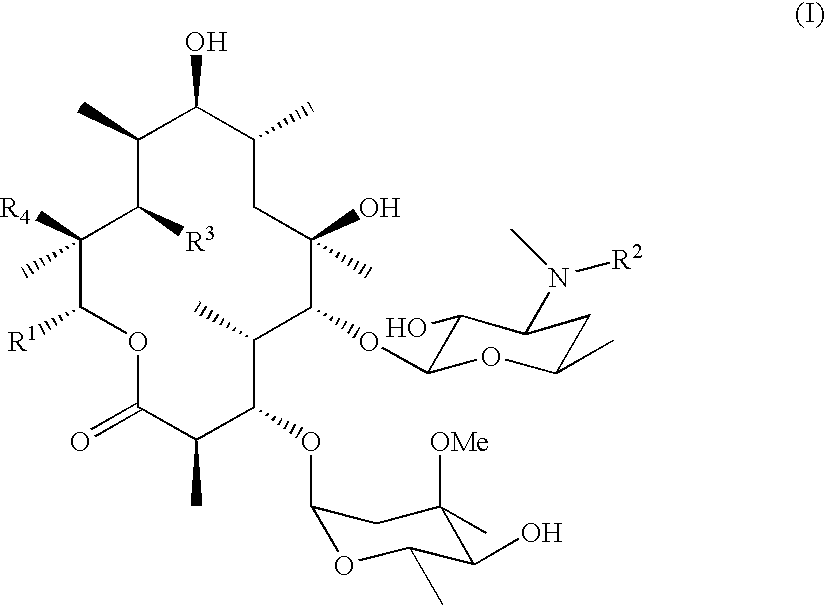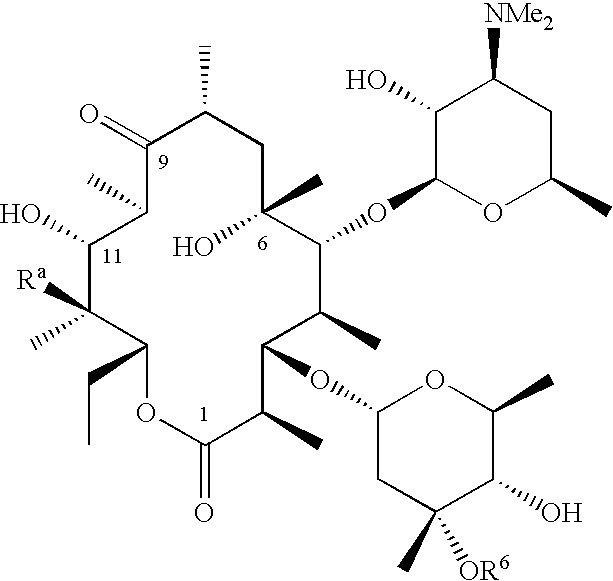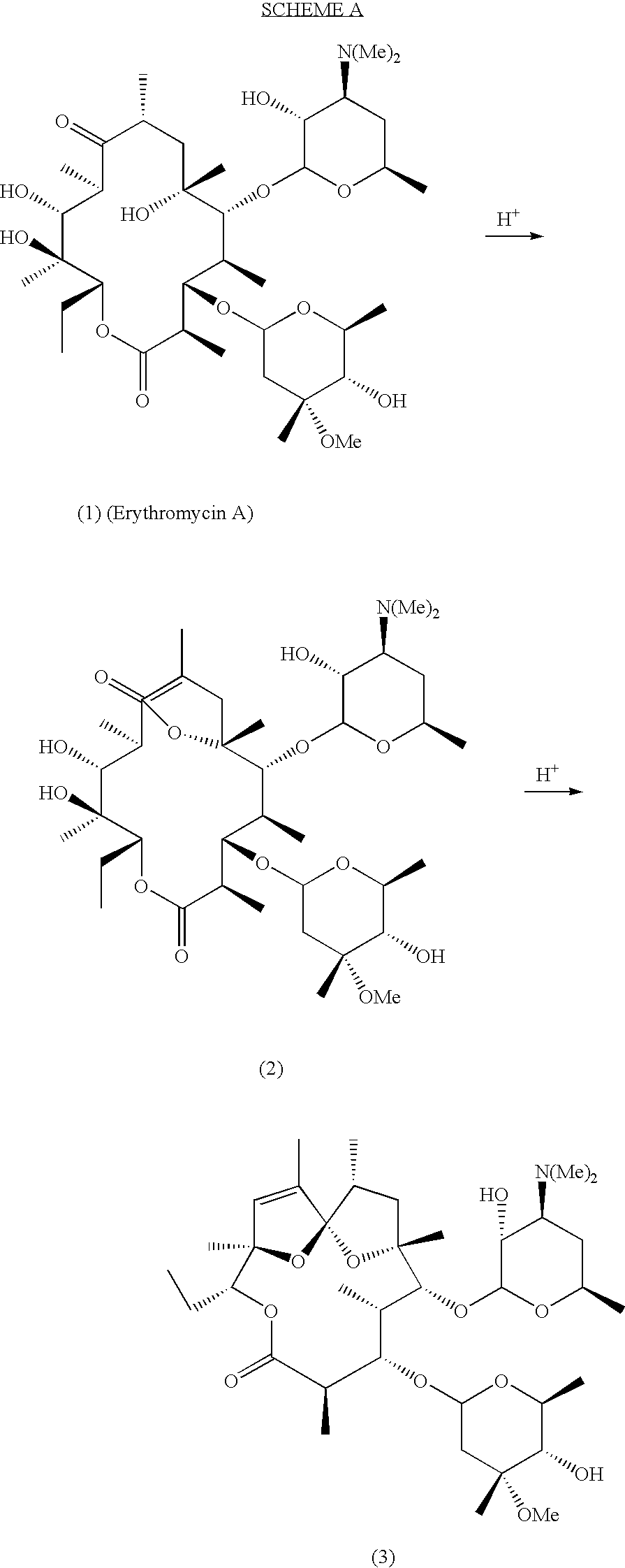Motilide compounds
a technology of molecular biology and compounds, applied in the field of prokinetic agents, can solve the problems of affecting the efficacy of erythromycin, and causing nausea, vomiting, abdominal discomfort, etc., and affecting the development of erythromycin a (1). , to achieve the effect of reducing the risk of side effects, desensitization, and reducing the
- Summary
- Abstract
- Description
- Claims
- Application Information
AI Technical Summary
Benefits of technology
Problems solved by technology
Method used
Image
Examples
example 1
[0071]This example describes the making of 15-methyl-6-deoxyerythronolide B (also referred to as 13-propyl-6-dEB or 15-methyl-6-dEB), an intermediate used in the synthesis of certain compounds of this invention. (Other erythronolides are analogously named; for example the erythronolide with a fluoro group instead of a methyl group at the 15-position is referred to as 15-fluoro-6-dEB.)
15-Methyl-6-deoxyerythronolide B
[0072]A 1 mL vial of the CH999 / pJRJ2 (Streptomyces coelicolor that contains a PKS in which the ketosynthase domain of module 1 has been inactivated by mutation) working cell bank is thawed and the contents of the vial are added to 50 mL of Medium 1 in a 250 mL baffled flask.
[0073]Medium 1 comprises 45 g / L cornstarch; 10 g / L corn steep liquor; 10 g / L dried, inactivated brewers yeast; and 1 g / L CaCO3. This solution is sterilized by autoclaving for 90 minutes at 121° C. After sterizilization, 1 mL / L of sterile filtered 50 mg / ml thiostrepton in 100% DMSO and 1 mL / L autoclave...
example 2
[0080]This example describes the conversion of 15-methyl-6-deoxyerythronolide B to 15-methylerythromycin A (formula II, R1═—CH2CH2CH3; R3═R4═OH). Conversion techniques are also taught in Carreras et al., J. Biotechnology, 92, 217-228 (2002). the disclosure of which is incorporated by reference.
[0081]A 1 mL vial from working cell bank K39-14V (an eryA mutant of S. erythraea that is incapable of producing 6-dEB) is thawed and the contents of the vial are added to 50 mL of Medium 2 in a 250 mL baffled flask.
[0082]Medium 2 comprises 16 g / L cornstarch; 10 g / L corn dextrin; 15 g / L soy meal flour; 4 g / L CaCO3; 5 g / L corn steep liquor; 6 g / L soy bean oil; 2.5 g / L NaCl; and 1 g / L (NH4)2SO4. This solution is sterilized by autoclaving for 60 minutes at 121° C. and 1 mL / L autoclaved 100% antifoam B silicon emulsion (J. T. Baker) is added prior to use.
[0083]The flask containing the thawed cells and Medium 2 is placed in an incubator / shaker maintained at 34±1° C. and 175±25 RPM for 48±10 hours. T...
example 3
[0091]This example describes a general method for the preparation of (9S)-9-dihydroerythromycins (formula II), with reference to Scheme 1.
[0092]A solution of the erythromycin (0.36 mmol) in 1:3 ethanol / ether (20 mL) is cooled to −15° C. and treated with sodium borohydride (0.9 mmol). The reaction is allowed to warm slowly to ambient temperature over 4 hours. The excess borohydride is destroyed by addition of phosphate buffer, pH 6, and 10 mL of triethanolamine is added. After 1 hour, the mixture is extracted with ethyl acetate, dried over MgSO4, filtered, and concentrated to dryness under reduced pressure. The product is purified by silica gel chromatography using 1:1 acetone-hexanes with 1% triethylamine. The following compounds were prepared using this procedure:[0093](9S)-9-dihydroerythromycin A;[0094](9S)-9-dihydro-15-methylerythromycin A; and[0095](9S)-9-dihydro-15-fluoroerythromycin A.
PUM
| Property | Measurement | Unit |
|---|---|---|
| Length | aaaaa | aaaaa |
| Density | aaaaa | aaaaa |
| Density | aaaaa | aaaaa |
Abstract
Description
Claims
Application Information
 Login to View More
Login to View More - R&D
- Intellectual Property
- Life Sciences
- Materials
- Tech Scout
- Unparalleled Data Quality
- Higher Quality Content
- 60% Fewer Hallucinations
Browse by: Latest US Patents, China's latest patents, Technical Efficacy Thesaurus, Application Domain, Technology Topic, Popular Technical Reports.
© 2025 PatSnap. All rights reserved.Legal|Privacy policy|Modern Slavery Act Transparency Statement|Sitemap|About US| Contact US: help@patsnap.com



